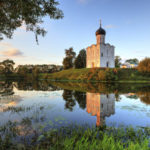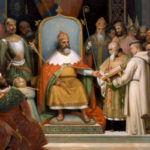Monastery of St. Catherine
 St. Catherine’s Monastery is the oldest Christian monastery in the world, located in Egypt, on the Sinai Peninsula at an altitude of 1570 meters, at the foot of Mount Sinai. Named for St. Catherine, tortured for preaching the Christian faith. The monastery of St. Catherine was founded in the IV century by Greek monks, next to the chapel of the Burning Cupids, erected in the biblical place of delivery of the Ten Commandments to Moses. In the VI century, the monastery was rebuilt as a fortress.
St. Catherine’s Monastery is the oldest Christian monastery in the world, located in Egypt, on the Sinai Peninsula at an altitude of 1570 meters, at the foot of Mount Sinai. Named for St. Catherine, tortured for preaching the Christian faith. The monastery of St. Catherine was founded in the IV century by Greek monks, next to the chapel of the Burning Cupids, erected in the biblical place of delivery of the Ten Commandments to Moses. In the VI century, the monastery was rebuilt as a fortress.
Monastery of St. Catherine is one of the most revered shrines of the Orthodox Church. And although he is far beyond the borders of our country, true Christians still go there, worship and turn with prayers and requests to St. Catherine, whose relics are in this holy place.
Many of our compatriots have a rest in resorts of Egypt, including in Sharm El Sheikh. Of course, the warm sun, the blue water of Nayama Bay, a clean sandy beach and other resort activities take time.
But few vacationers know that not far from Sharm El Sheikh, in the valley, in the oasis of Wadi Firan, between the mountains of Moses, Catherine and Safsaf, at the foot of Moses, or along the biblical Mount Sinai, at an altitude of 1570 meters, there is one of the most revered Christian shrines.
In the III century, near the Burning Canopy, in the caves of Mount Sinai the monks of hermits began to settle. They led a secluded lifestyle and only on holidays did they gather for the joint worship at the Burning Canopy. This place was revered not only by monks, but also by high-ranking people of that time.
The mother of Emperor Constantine, St. Helena, at the request of the monks, in 324 ordered to build a small chapel on this site – a chapel, around which over time a monastery was established, which was called the “Monastery of the Burning Kupina”. The inhabitants of the monastery were Orthodox Greeks. In many scriptures, he is also referred to as the “monastery of the Transfiguration.” Since the monastery was often raided by nomadic tribes, the Byzantine emperor Justinian I in 537 converted this monastery into a real fortress. Around the monastery were built high fortified walls with loopholes, and inside, in addition to the monks, there was a military garrison defending the holy place. In this form, the monastery-fortress has survived to our time.
In those days, when these events took place, paganism was the main religion in Egypt. Christianity was just beginning its entry into the consciousness of people. It made its way with great difficulties. Advocates of paganism, especially the imperial elite, their close and pagan priests were ardent opponents of Christianity and in every way persecuted the preachers of the Christian faith. But, in spite of everything, they knew and accepted the Christian faith, sometimes even at the cost of their lives, carried it to people.
One of these enlighteners was Dorothea – the daughter of one of the noble people of Alexandria, born at the end of the 3rd century. A beautiful, intelligent and educated girl, having met a hermit monk, learned from him about Jesus Christ and the existence of a true Christian faith. She believed in Jesus Christ as the Son of God and joyfully accepted this faith, was baptized and called Catherine.
There are many beliefs about her life. But they all agree that Catherine was engaged to Christ and devoted her whole life to preaching the Christian faith. She even tried to convert Maximin, the co-emperor of Byzantium, to Christianity. For the refusal to renounce Christianity, Catherine was subjected to torture and executed. The body of tortured Catherine was buried in the Sinai Mountains. Three centuries later, the monks found her remains and transferred them to the temple at the monastery. Catherine was counted among the saints, and her relics are still kept in the monastery in the main monastery church. The mountain, where the remains of St. Catherine were found, has since bears her name. And in the XI century, when the entire burial place of St. Catherine was known to all Christian humanity, the Monastery of the Burning Bush became a pilgrimage site for a huge number of believers. And then the Monastery of the Burning Dome in her honor was renamed the Monastery of St. Catherine.
The monastery of St. Catherine is revered not only by Christians, other religions recognize his holiness. That is why, in the entire history of Egypt during the New Era, the monastery was never damaged or plundered. When the Arabs captured the Sinai Peninsula, the Prophet Muhammad himself patronized the monastery. A Muslim mosque was erected on the territory of the monastery, which became a watchman symbol from Muslim raids and practically saved it from destruction. During the Crusades, to protect the pilgrims, a knightly order of St. Catherine was created at the monastery, and a Catholic church was built in the monastery itself. And even when the Ottoman Empire conquered Egypt in the 16th century, the Turkish Sultan retained the special position of Archbishop Sinai and did not interfere in the affairs of the monastery.



























